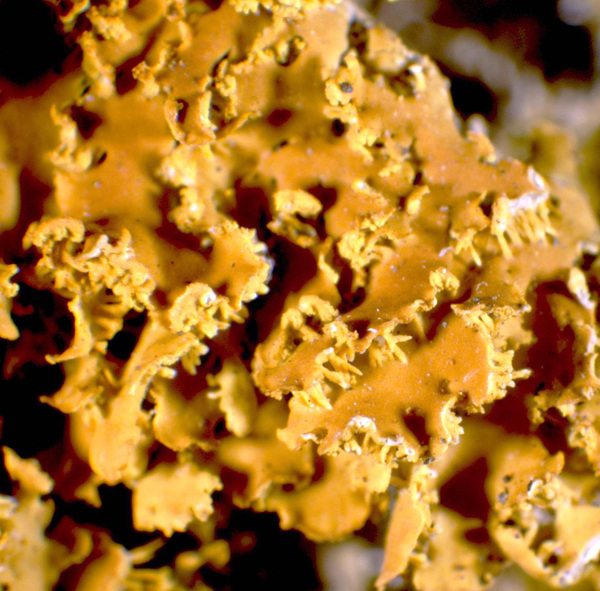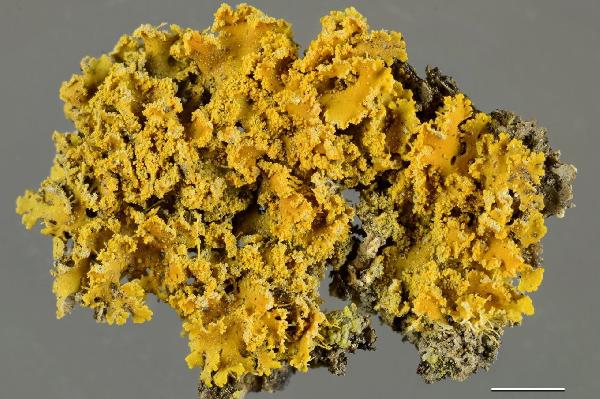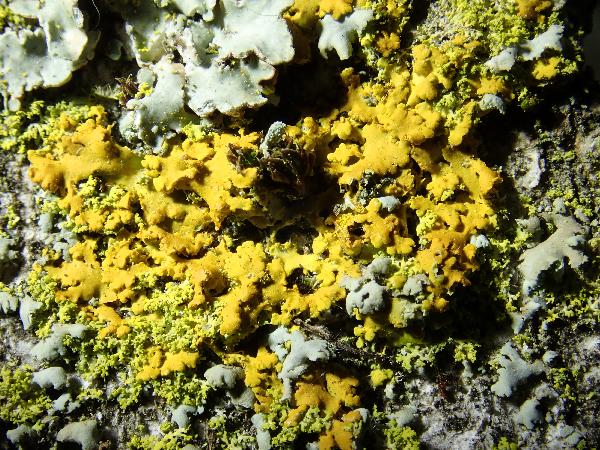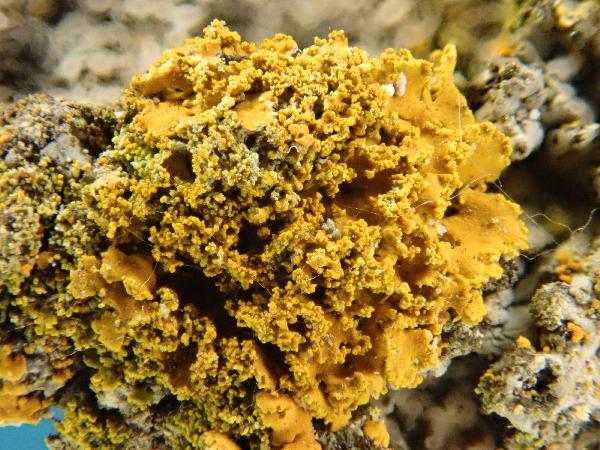Xanthomendoza ulophyllodes (Räsänen) Søchting, Kärnefelt & S.Y. Kondr.
Mitt. Inst. allg. Bot. Hamburg, 30-32: 238, 2002. Basionym: Xanthoria ulophyllodes Räsänen - Ann. Acad. Sci. Fenn., 34, 4: 105, 1931.
Synonyms: Oxneria ulophyllodes (Räsänen) S.Y. Kondr. & Kärnefelt; Parmelia parietina var. fibrillosa Schaer.; Physcia controversa var. stenophylla A. Massal.; Xanthoria stenophylla (Harm.) B. de Lesd.; Xanthoria substellaris var. isidiigera Räsänen
Description: Thallus foliose, heteromerous, dorsiventral, orange, forming up to 3.5 cm wide rosettes which often coalesce to cover much larger surfaces. Lobes loosely adnate to semi-erect, flattened at least in older parts, up to 5(-8) mm long, 0.3-0.5(-1.5) mm wide, the ends ascending, lip-shaped and blastidiate on lower surface, the blastidia 20-30 µm in diam, often gathered into 40-50(-60) µm wide conblastidia. Lower surface white, smooth to somewhat wrinkled, with abundant, white to yellow rhizines. Upper and lower cortex paraqlectenchymatous; medulla white. Apothecia rare, lecanorine, stipitate, with an orange disc and an often blastidiate thalline margin. Thalline exciple paraplectenchymatous; proper exciple a strongly gelatined plectenchyma with unoriented, short-celled hyphae; epithecium orange-brown, K+ purple-red, c. 10 µm high; hymenium colourless, 20-80 µm high; paraphyses simple or sparingly branched; hypothecium colourless to pale brown, 25-70 µm high. Asci 8-spored, clavate, functionally unitunicate, apically thickened with a broad internal beak, the inner part of apex and external cap I+ blue, Teloschistes-type. Ascospores 2-celled, polarilocular, hyaline, ellipsoid, narrowed at apex, 10.5-15(-16) x 6-7(-8) µm, the equatorial thickening (“septum”) 3.5-5 µm. Pycnidia common, immersed or slightly projecting, slightly darker orange than thallus. Conidia bacilliform, 2.5-4 x 1-1.5 µm. Photobiont chlorococcoid. Spot tests: thallus and apothecia K+ purple-red, C-, KC-, P-, UV+ orange. Chemistry: parietin (major), fallacinal (major), emodin, teloschistin (major) and parietinic acid (chemosyndrome A3 of Søchting 1997).
Growth form: Foliose, narrow lobed
Substrata: bark
Photobiont: green algae other than Trentepohlia
Reproductive strategy: mainly asexual, by soredia, or soredia-like structures (e.g. blastidia)
Subcontinental: restricted to areas with a dry-subcontinental climate (e.g. dry Alpine valleys, parts of Mediterranean Italy)
Commonnes-rarity: (info)
Alpine belt: absent
Subalpine belt: absent
Montane belt: very rare
Dry submediterranean belt: rare
Humid submediterranean belt: absent
Padanian area: absent
pH of the substrata:
1 2 3 4 5
Solar irradiation:
1 2 3 4 5
Aridity:
1 2 3 4 5
Eutrophication:
1 2 3 4 5
Poleotolerance:
0 1 2 3
Altitudinal distribution:
1 2 3 4 5 6
Rarity
absent
extremely rare
very rare
rare
rather rare
rather common
common
very common
extremely common
Loading data...
Occurrence data
Predictive map
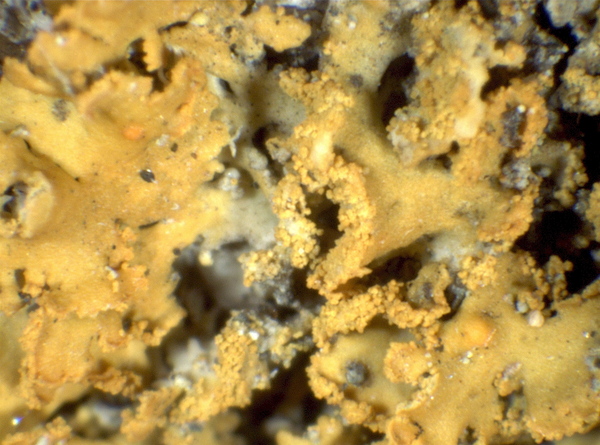
P.L.Nimis; Owner: Department of Life Sciences, University of Trieste
Herbarium: TSB (37026)
2008.02.25
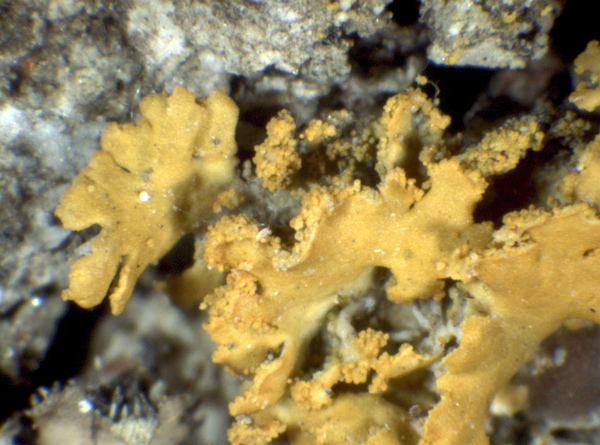
P.L.Nimis; Owner: Department of Life Sciences, University of Trieste
Herbarium: TSB (37026)
2008.02.25
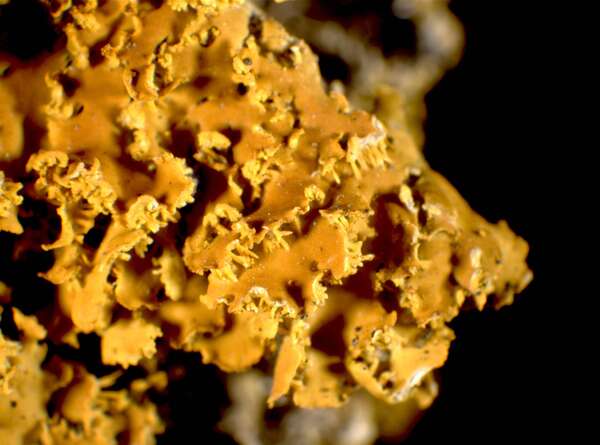
P.L. Nimis; Owner: Department of Life Sciences, University of Trieste
Herbarium: TSB (17995)
2001/12/03
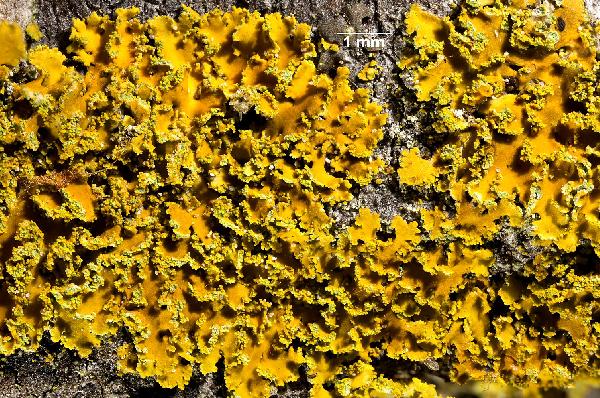
Ulrich Kirschbaum CC BY-SA 4.0 – Source: https://www.thm.de/lse/ulrich-kirschbaum/flechtenbilder
Central Europe; Germany: Bavaria. on Aesculus
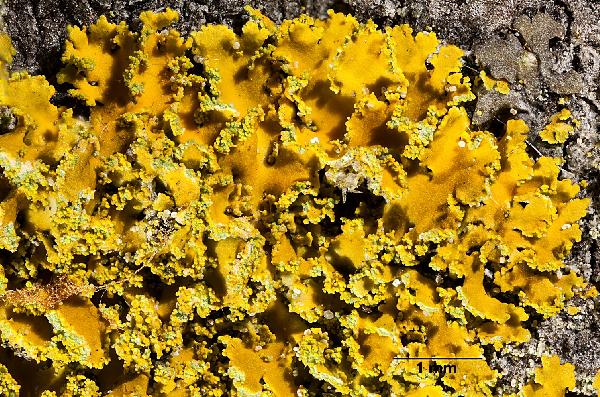
Ulrich Kirschbaum CC BY-SA 4.0 – Source: https://www.thm.de/lse/ulrich-kirschbaum/flechtenbilder
Central Europe; Germany: Bavaria. on Aesculus
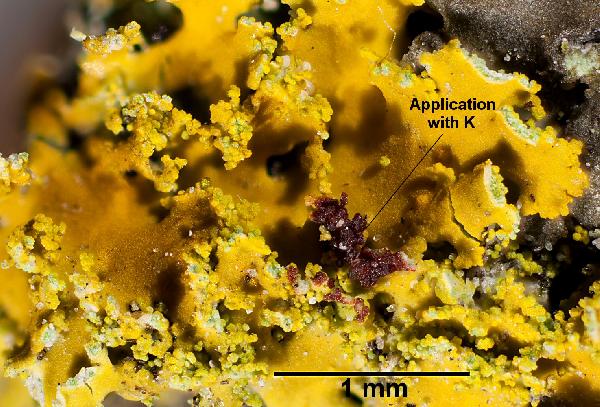
Ulrich Kirschbaum CC BY-SA 4.0 – Source: https://www.thm.de/lse/ulrich-kirschbaum/flechtenbilder
Central Europe; Germany: Bavaria. on Aesculus
Growth form: Foliose, narrow lobed
Substrata: bark
Photobiont: green algae other than Trentepohlia
Reproductive strategy: mainly asexual, by soredia, or soredia-like structures (e.g. blastidia)
Subcontinental: restricted to areas with a dry-subcontinental climate (e.g. dry Alpine valleys, parts of Mediterranean Italy)
Commonnes-rarity: (info)
Alpine belt: absent
Subalpine belt: absent
Montane belt: very rare
Dry submediterranean belt: rare
Humid submediterranean belt: absent
Padanian area: absent
pH of the substrata:
| 1 | 2 | 3 | 4 | 5 |
Solar irradiation:
| 1 | 2 | 3 | 4 | 5 |
Aridity:
| 1 | 2 | 3 | 4 | 5 |
Eutrophication:
| 1 | 2 | 3 | 4 | 5 |
Poleotolerance:
| 0 | 1 | 2 | 3 |
Altitudinal distribution:
| 1 | 2 | 3 | 4 | 5 | 6 |
Rarity
absent
extremely rare
very rare
rare
rather rare
rather common
common
very common
extremely common
Loading data...
Occurrence data
Predictive map

P.L.Nimis; Owner: Department of Life Sciences, University of Trieste
Herbarium: TSB (37026)
2008.02.25

P.L.Nimis; Owner: Department of Life Sciences, University of Trieste
Herbarium: TSB (37026)
2008.02.25

P.L. Nimis; Owner: Department of Life Sciences, University of Trieste
Herbarium: TSB (17995)
2001/12/03

Ulrich Kirschbaum CC BY-SA 4.0 – Source: https://www.thm.de/lse/ulrich-kirschbaum/flechtenbilder
Central Europe; Germany: Bavaria. on Aesculus

Ulrich Kirschbaum CC BY-SA 4.0 – Source: https://www.thm.de/lse/ulrich-kirschbaum/flechtenbilder
Central Europe; Germany: Bavaria. on Aesculus



